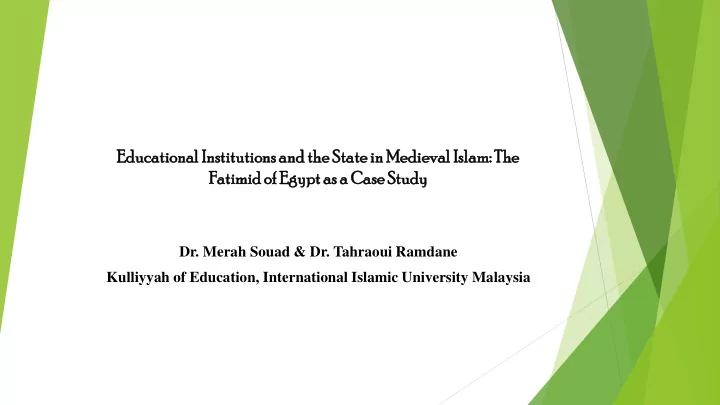

Educ ucat ation ional l Institutio stitutions s and d the he State ate in Med edieva eval l Islam lam: : The he Fatimid timid of f Egypt pt as a Case e St Stud udy Dr. Merah Souad & Dr. Tahraoui Ramdane Kulliyyah of Education, International Islamic University Malaysia
Introduction “Wherever a man who knew how to read met another who was not quite so fortunate, yet willing to learn, a school was organized. It may have been under a palm tree, in a tent, or in a private house; nevertheless it was a school.” (Khalil A. Totah)
Objectives In Medieval Islam, religious schism reached its zenith due to the fact that it has taken the form of ideologies that fed the legitimacy of any political regime claimed by the many rival Muslim dynasties. Thus, it created several new educational challenges, which paved the way for the states to officially began, to participate in monitoring learning activities especially in terms of finance and the establishment of the different educational institutions..
Objectives This presentation will discuss the role of the different educational institutions and their relationship with the state through the case study of the Fatimids of Egypt.
The Fatimids (358/567 AH) (969/1171 AD) : History and Ideology They have been named the Fatimids because of their claim to be the descendants of Fatima, daughter of prophet Muhammad (pbuh), and wife of Ali bin Abi Talib the fourth rightly guided caliph and the first shi’a imam. They have also been called “ Ubaidis ” in reference to the founder of the Fatimids dynasty ‘ Ubayd Allah Al- Mahdi Billah.
Education during the Fatimids Education was looked upon as a mean to achieve the Following: To maintain the status quo and secure the continuity of the dynasty. To Reproduce the political regime To protect the official madhab.
Relationship between Curriculum and the adopted Madhab Therefore the special relationship between the political objectives of the regime and the educational system was demonstrated in the following: In their capacity as imams, the Fatimids caliphs used to personally supervise both , educational and da’wah activities inside and outside.
Propaganda and education were inseparable: “It was not enough to formulate ideology; there was also the more practical business of disseminating it. In this respect, the mission performed many tasks which a modern observer, depending on his point of observation, might classify as education .” ( Bernard Lewis, Interpretation of Fatimid History, Cairo, Egypt: Colloque Internationale sur l’Histoire de Caire, 27 Mars-5 April 1969, Pg7 )
If we consider the Fatimids ’ da’wah (missionary network), reflective of the Fatimids system of education and curriculum, then the main feature of the curriculum was its evident flexibility.
The ismaili madhab (sect) is supreme and it must be served by all active social institutions including education. Thus, the hierarchy of the da’wah (call) structure was sacred, and every member of this structure regarded it as divine. There is a belief that the ismaili da’wah and ilm (knowledge) are of a universal nature. Thus, the curriculum was designed in a way that is catering to the needs of the whole society: Sunni majority and the minority ismaili ruling elite.
Types of Curriculum and Murids(students) Exoteric public legal curriculum designed for the general public. It involved what was not politically embarrassing to the Fatimids in front of their Sunni subjects. It caters to the needs of Young learners, Adults(casual students & regular students) Esoteric curriculum , it was designed for al- khassah (elite)and the varying ranks of da’is (missionary) , such as da’i al Balagh , da’i al Mahsur , da’I al Mutlaq , and also for the mustajibs (respondent) . It involves all controversial knowledge, which they were not comfortable to display to the public. Target groups were : Ahl al Bayt (prophet’s family) , prominent people, Shuyukh al dawlah (state scholars) potential mustajibs.
This curriculum was delivered in what was called: Majalis al Hikmah the later was looked upon with great veneration. Heinz Halm (1997) in his study about the Fatimids and their traditions of learning has given us a unique interpretation of the famous story of al-Alim wa al-Ghulam (the teacher and the pupil). This story emphasizes on the exclusivity of these majalis , how sophisticated is the selection of its murids, their stratification and the sacred process of initiation each murid has to pass through, in order to gain full membership. This long process of rites of passage symbolizes the student’s new birth. It acquaints him with a new world of rituals and meanings.
Major Academic Disciplines Theology Literary studies, syntax, rhetoric, composition, reading . Philosophy Military Sciences History Al – Taawil (Interpretation)
Educational Institutions Al Azhar Mosque. Dar Al Hikmah (House of Wisdom) Jami’s ( Halaqas, Majalis al Ilm, Majalis al Munazarah). Maktabas (Libraries) and Markets of booksellers. Kuttabs Ribats Bimaristans
Lifelong Learning Principles as Demonstrated in Medieval Practices Flexibility of the curriculum The pivotal role of the scholars The liberal culture of learning No restrictions in adherence No restrictions in relation to age Different madhabs enjoyed freedom of expression: Learning by conviction Education was not controlled by the labor market requisites Non-credential Education AL-waqf
Thank you
Recommend
More recommend